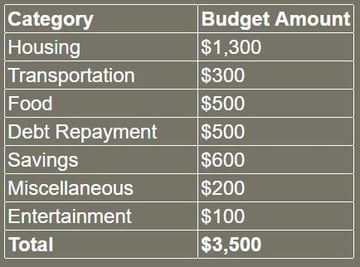
Budgeting 101: How to Take Control of Your Finances
Budgeting empowers you to take control of your finances by providing clarity, reducing stress, and helping you align your spending with your goals. By assessing income, tracking expenses, setting clear goals, and choosing a budgeting method, you can build sustainable habits that lead to financial freedom and peace of mind.
WEALTH
1/26/20255 min read


Budgeting 101: How to Take Control of Your Finances
Managing money can often feel overwhelming, but it doesn’t have to be. A well-crafted budget is your roadmap to financial clarity, giving you the control you need to meet your goals and reduce financial stress. Whether you’re saving for a big purchase, paying off debt, or simply trying to make ends meet, a budget is your best ally. In this guide, we’ll walk you through the basics of creating and sticking to a budget that works for you.
Why Budgeting Matters
A budget isn’t just about tracking expenses; it’s about empowerment and understanding. By taking the first step to observe and understand your financial habits, you gain clarity and can start making conscious changes. Budgeting doesn’t have to feel restrictive or stressful—it’s an adaptable process that evolves as you learn more about your spending.
Here are some key benefits of budgeting:
Financial Awareness: Understand where every dollar goes and identify spending patterns.
Goal Achievement: Allocate resources toward savings, debt repayment, or investments.
Stress Reduction: Gain peace of mind by avoiding financial surprises and feeling in control.
Improved Spending Habits: Recognize unnecessary purchases and redirect funds to what truly matters.
Budgeting is all about that first step of observation—it’s not about immediate change or judgment. Once you see where your money is going, you’ll naturally begin to adapt over time, making decisions that align with your bigger goals.
Step 1: Assess Your Income
Understanding is the first step to gaining control of your finances. Start by determining how much money you have coming in each month. This step is about observation, not judgment.
Calculate your total monthly income from all sources, including:
Your salary (after taxes)
Side hustles or freelance work
Passive income (e.g., rental properties or investments)
Pro Tip: Automate payments and savings to reduce the temptation of spending money allocated for other purposes.
Step 6: Monitor and Adjust
No budget is perfect on the first try, and that’s okay. Observation remains crucial as you tweak your allocations over time. Here’s how to stay on track:
Track Weekly: Regularly review your spending and compare it to your budget.
Adjust Categories: If you overspend in one area, adjust by reallocating funds from another.
Ask Yourself Questions: For discretionary purchases, ask, “Does this benefit me or align with my goals?” Often, this reflection will help you avoid unnecessary spending. If you feel like you’re avoiding asking yourself this question, try to dig deeper and ask yourself why.
Celebrate Wins: Even small progress, like cutting back on dining out, is worth acknowledging.
Remember, budgeting is about empowering yourself to make better decisions over time. I review my budget each month in a non-judgemental way, celebrating where I have saved and observing where I have spent more. Maybe I spent additional funds on travel in the past month but if it gave me an enriching experience that I was looking for, it was absolutely worth it for me. On the other hand, if you are a homeowner and you had to spend money on a new boiler last month, be grateful that a potential risk is out of the way and you are in the clear for the next 15+ years. Every observation you make provides you with peace of mind and brings you closer to financial freedom.
Common Budgeting Challenges (and How to Overcome Them)
Inconsistent Income:
Base your budget on the lowest expected income and save surplus earnings for leaner months.
Unexpected Expenses:
Build an emergency fund with 3-6 months of essential expenses to handle surprises.
Impulse Spending:
Implement a 24-hour rule before making non-essential purchases to avoid buyer’s remorse.
Lack of Motivation:
Revisit your goals and visualize the benefits of sticking to your budget.
Final Thoughts
Budgeting isn’t about restriction—it’s about freedom. By observing and understanding your finances, you can make informed choices that align with your goals. Start small and focus on building sustainable habits. Over time, you’ll naturally adapt to spending intentionally, and your financial health will improve.
Remember, every step you take toward understanding and managing your finances is progress. Ready to take control of your finances? Start your budget today! If you need help taking the first step, don't be afraid to reach out!


Pro Tip: If your income varies, use conservative estimates or average it over a few months to ensure accuracy.
Step 2: Track Your Expenses
Observation is key here. Before making any changes, take a close look at your spending. Review your bank statements and categorize your expenses for the past 2-3 months. This process helps you see exactly where your money is going.
Common categories include:
Housing: Rent, mortgage, utilities
Transportation: Gas, public transit, car maintenance
Food: Groceries, dining out
Debt Repayment: Credit cards, loans
Savings: Emergency fund, retirement
Miscellaneous: Entertainment, subscriptions, personal care
This step is purely about understanding—not changing your habits yet. You’ll likely start noticing patterns and areas where small adjustments


could make a big difference over time. For instance, are you buying coffee daily instead of brewing at home? Can you make a bigger portion of dinner tonight to bring for lunch tomorrow? Is there some subscription service that you’re not getting regular use out of? Cancel it for this month even if you re-subscribe the next month. Small changes add up.
Pro Tip: Use apps like Mint, YNAB, or spreadsheets to track expenses efficiently. Personally, I opt for the traditional spreadsheet just because I like to have the control of categorizing each expense for myself.
Step 3: Set Financial Goals
Setting clear goals gives your budget a purpose. Think about what you want to achieve financially in the short and long term. Examples include:
Building a $1,000 emergency fund
Saving for a vacation or large purchase
Paying off high-interest debt
Investing for retirement
Write these goals down and prioritize them. Reflect on how every purchase either moves you closer to or further from these goals. Before buying something non-essential, ask yourself: Does this purchase benefit me in the long term? Does it align with my goals? Short-term gratification can often pull you away from what you truly want, but holding out for your bigger goals can be empowering and rewarding.
Step 4: Choose a Budgeting Method
There’s no one-size-fits-all approach to budgeting. Experiment with different methods to find what aligns with your lifestyle and goals. Here are some popular ones:
50/30/20 Rule:
50% for needs
30% for wants
20% for savings and debt repayment
Zero-Based Budgeting:
Assign every dollar a purpose until your income minus expenses equals zero.
Envelope System:
Allocate cash for different categories and spend only what’s in the envelope.
Pay Yourself First:
Save a set amount before allocating money for other expenses. This method ensures your goals take priority.
Each method emphasizes awareness, but you can tweak them as you go. If something isn’t working, adapt—budgeting is flexible.
Step 5: Create Your Budget
Using your chosen method, map out your income and expenses. Be realistic and flexible. Budgets aren’t static—they’re living documents that adapt to your needs.
Here’s an example budget for an income of $3,500 per month:
